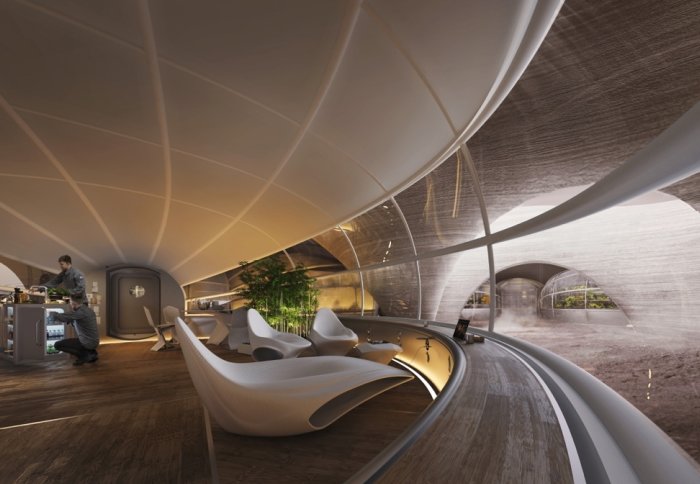How to design for a move to Mars

Mars habitat concept. Credit: HASSELL studio
Academics, designers and students discussed the design challenges of moving to Mars and potential solutions during a symposium at the Design Museum.
How do we protect astronauts from dangerous radiation or the effects of bone wasting in lower gravity? How do we make sure nothing is wasted when we get there? And how do we keep astronauts happy?
Imperial College London teamed up with the Design Museum to explore these questions and more in a special event to coincide with the Museum’s Moving to Mars exhibition. The event also included a showcase of new design ideas from students on the Innovation Design Engineering Masters, run jointly by the Royal College of Art and the Dyson School of Design Engineering at Imperial.
Looking after the body
Head of Imperial’s Space Lab Dr Jonathan Eastwood, and designer-researcher Anna Tavli discussed the human body on Mars. Dr Eastwood, from the Department of Physics at Imperial, talked about the dangers of space weather, such as how unfiltered radiation from the Sun could damage astronaut bodies and spacecraft electronics.
For more on Dr Eastwood’s work with space weather and how he is involved in a mission to track it, listen to the audio clip below.
Anna Tavli talked about her work designing astronaut clothes that re-position the body to keep load-bearing muscles moving, preventing bone wasting. She also talked about how the whole body needs looking after as well as astronauts’ wellbeing, sharing a design for gloves that hold particular scents from home that are important to each astronaut.
She said: “So far the bare minimum is enough as journeys and stays in space are short. But if we are taking a few years to get to Mars and back, we need to replicate what makes us happy – like scents and textures that we are used to Earth.”
Living on the surface of Mars
The Design Museum’s Designer in Residence 2019, Mále Uribe Forés, and Professor Tom Pike from the Department of Electrical and Electronic Engineering at Imperial discussed Martian landscapes.
Mále highlighted the Atacama desert on Earth as a proxy for Martian landscapes, both with extreme dryness and rocks that have been unaltered for a long time. She also pointed to the desert as a local example of some of the issues we could face on Mars when mining for resources, such as water use and contamination.
Professor Pike is part of a team that built a seismometer that has just spent its first year on Mars hunting for ‘Marsquakes’ as part of NASA’s Mars InSight mission. Marsquakes, he says, could provide clues about the interior of the planet and the potential for past life on Mars. He says the information may reveal how our planet could have taken ‘wrong turns’ like Mars and ended up barren and inhospitable.
He also said that by designing a sensor for Mars, the team now have a sensor that can be applied to lots of questions on Earth, such as being placed on large icebergs to track their movement.

Professor Sanjeev Gupta from the Department of Earth Science and Engineering at Imperial, and Lydia Kallipoliti from Cooper Union in New York, explored the practicalities and ethics of living on Mars.
Lydia discussed the architecture of ‘closed worlds’, and how previous attempts at self-sustaining living systems can inform designs for habitats on Mars – both in what to do and what not to do.
Professor Gupta asked why we should go to Mars and how this differs from previous colonisations of new lands. He said: “We are not looking for material wealth, but scientific wealth. To do that, we need human ingenuity to explore the complex landscape of rocks.”
But would our participants move to Mars? We asked academics and students for their thoughts – listen to the audio clip below and decide for yourself.
Designing for life
Students from Imperial and the Royal College of Art joint Masters program took part in a 48-hour make-a-thon to come up with design concepts for living on Mars.
Hear about some of their projects in the audio clip below, from mobile habitats to zero-waste shoes and talons for moving in microgravity.
Article text (excluding photos or graphics) © Imperial College London.
Photos and graphics subject to third party copyright used with permission or © Imperial College London.
Reporter
Hayley Dunning
Communications Division